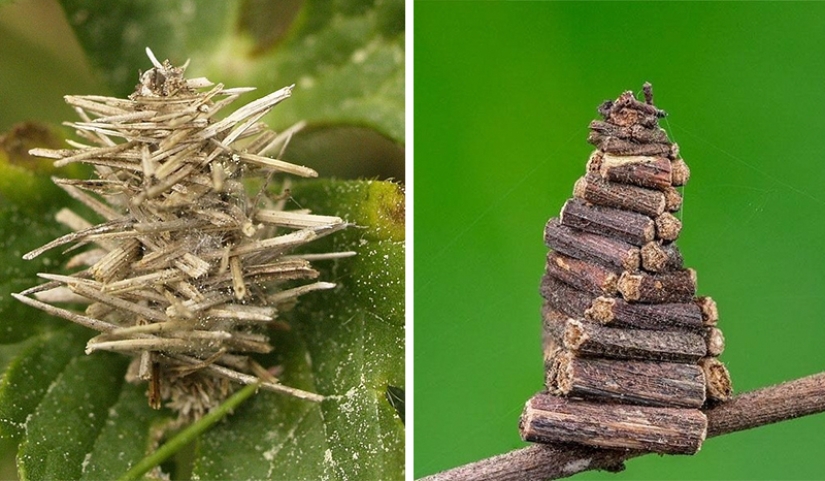Bagworm caterpillar: a small miracle in a case
Categories: Animals | Nature | World
By Pictolic https://pictolic.com/article/bagworm-caterpillar-a-small-miracle-in-a-case.htmlWe call “bag sellers” people who sell something in bags. But what does a small, inconspicuous bagworm butterfly, similar to a fly, have in common with strong, ruddy market traders? It turns out that this species owes its name to its caterpillars. They create a cocoon-bag, “encrusted” with various small debris. The caterpillars do not part with it and carry it with them everywhere, like hermit crabs their shell.

In Latin, bagworms are called more euphoniously - Psychidae. The caterpillar begins to build its cocoon immediately, as soon as it hatches from the egg. Sometimes they start urgent work even after forgetting to eat for the first time! This is not surprising, because the caterpillar will not feel safe until it hides in its house.

The base of the cover is a silk thread, which is produced by silk glands located near the mouth. This work is not easy, because the caterpillar is constantly growing, which means it must continue to weave its bag. Inside the cocoon it is calm and cozy. The larva carefully monitors the cleanliness and condition of the air.

Excrement and other contaminants are immediately thrown out. High humidity and dirt can lead to the appearance of mold in the cocoon, which is deadly for the caterpillar. Therefore, bagworms love dry places well warmed by the sun. They search for food mainly during the day, choosing clear weather for this.

The caterpillar moves along with its case, sticking out the front part of its body. Even when covering her cocoon with small debris, she prefers not to leave her home completely. The bagworm carefully selects “building materials”, takes them in her paws and, moistening them with sticky saliva, attaches them to her cocoon. The purpose of this work is to make the case more durable and less noticeable.

The bagworm family consists of 1,300 species living over vast areas in Africa, Asia, South and North America. Depending on the species and habitat, the materials covering the cocoon differ. Caterpillars that live on plants, such as the pea bagworm, use dry stems. And those living on the ground prefer grains of sand and the remains of shells of land mollusks.

The shape of the cocoon also differs. Most often they are elongated, oval, round or triangular in cross-section. But there are more intricate options. For example, psyched snails (Apterona helicoidella) build a spiral cocoon, which is how they got their name. They cover it with soil particles, grains of sand and their own excrement. The caterpillar also has a spiral shape, which it retains even after turning into a pupa.



No less amazing are the caterpillars of Dalcerid butterflies, which are called crystal butterflies.
Recent articles

If we talk about multi-faceted talented individuals, then we can safely cite Pavel Vlasov as an example. Although this name won't ...

In the estates of landlords under serfdom, servants of various profiles lived and worked. It was believed that the more servants a ...

New York-based photographer Ryan McGinley is known for his unusual, heart-wrenching projects. His series "Kiss and Make ...